Ebook Việt Hoá] Plant parenting: Easy ways to make more houseplants vegetables and flowers - LESLIE F. HALLECK
[Ebook Việt Hoá] Plant parenting – LESLIE F. HALLECK (Nhân giống cây) – HUMIDITY DOMES (Hộp giữ ẩm)
- Nguồn: [Ebook Việt Hoá] Plant parenting: Easy ways to make more houseplants, vegetables, and flowers – LESLIE F. HALLECK (Nhân giống cây: Những cách dễ nhất để nhân giống cây cảnh trong nhà, rau và hoa)
- Biên tập: Dũng Cá Xinh (Tháng 08/20201)
- Dịch: Huyền Nguyễn
English
Managing temperature and humidity can be tricky inside a typical home that runs air conditioners and heaters. The low humidity in our homes can quickly dry out young plants or seeds as they are trying to germinate. Don’t have a greenhouse? No problem. By using a humidity dome on top of your seed trays, you can replicate greenhouse conditions on a smaller scale. You can purchase humidity domes separately to fit on plug trays or to cover other types of containers. There are also numerous mini-greenhouse kits available for purchase that come with everything you need to manage humidity for your young seedlings and rooted cuttings.
Many humidity domes have top or side vents. After the seeds have germinated and begin growing or cuttings begin to root, you can open the vents to slowly reduce humidity. If too much water begins condensing inside the dome, or you keep the humidity dome on too long, fungal diseases or rot could set in. While young seedlings and cuttings do need to remain moist, too much moisture in the air around the seedlings can promote damping off disease, which causes seedlings or cuttings to rot at the soil line and topple. Too much humidity also encourages powdery mildew on young seedlings, cuttings, and transplants. You can remove the humidity dome or other cover once all your seedlings have germinated or cuttings have rooted and begin to produce new green growth.
You can also use a variety of other plastic con- tainers with clear covers. You know all those take-out containers that come with clear plastic lids or small vegetable containers from restaurants or the grocery store? I use them frequently as mini-seed-germination greenhouses. It’s a great way to recycle and reuse this type of plastic.
If you don’t have a humidity dome or other type of plastic container, you can use clear plastic bags
to enclose pots or small trays of cuttings to increase humidity. Choose a clear, non-porous, plastic bag large enough to accommodate your container and cutting without compressing them. Set an individual pot, sev- eral pots, or small seed trays inside the bag. Blow some air into the bag to inflate it, and then use a twist tie to close the end of the bag. This method is good when you’re rooting individual or small groups of vegeta- tive cuttings. You can also use bell jars and terrarium covers to increase humidity around vegetative cuttings and seedlings.
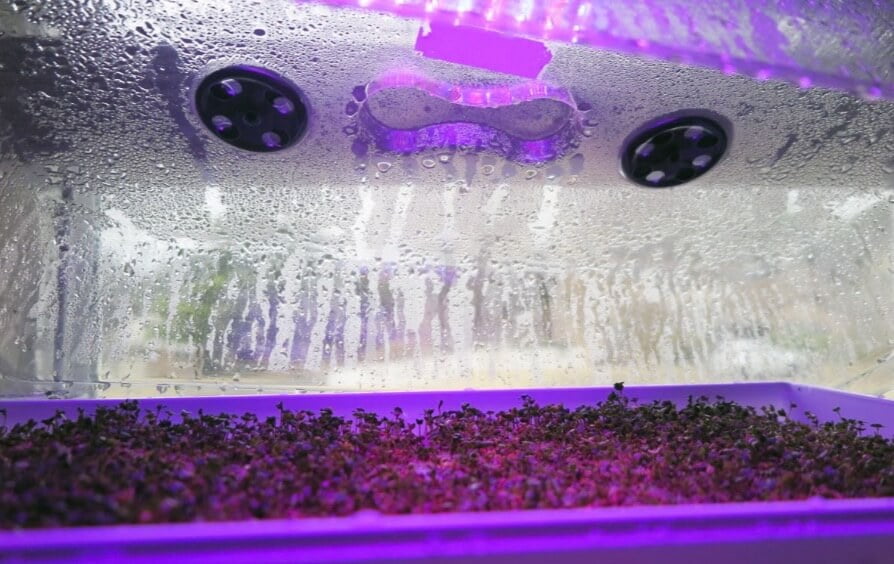
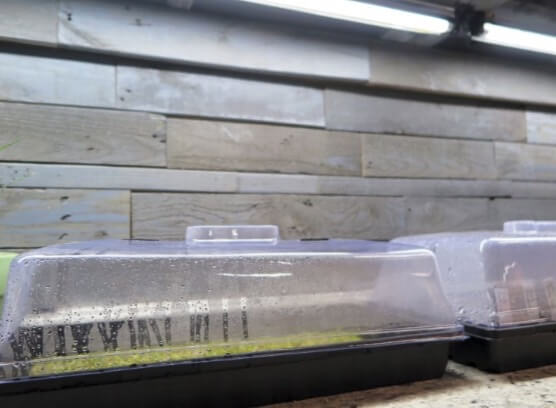
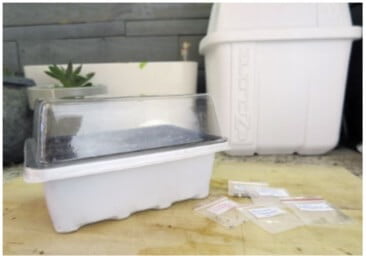
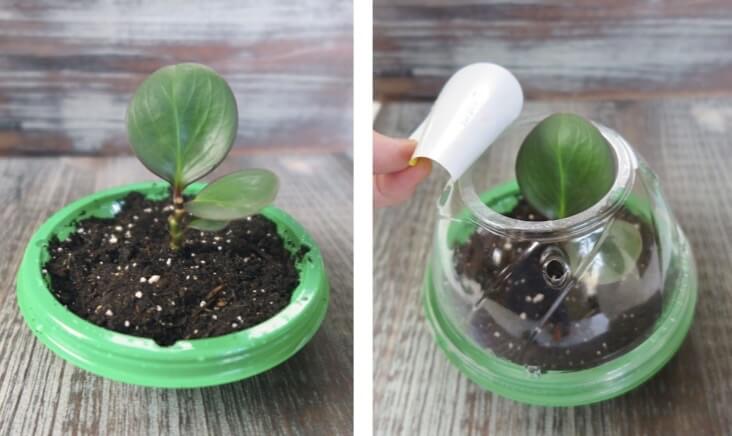
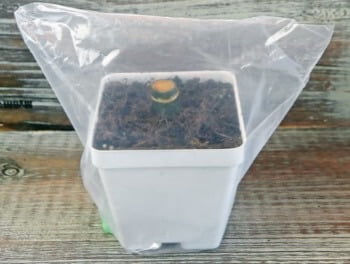
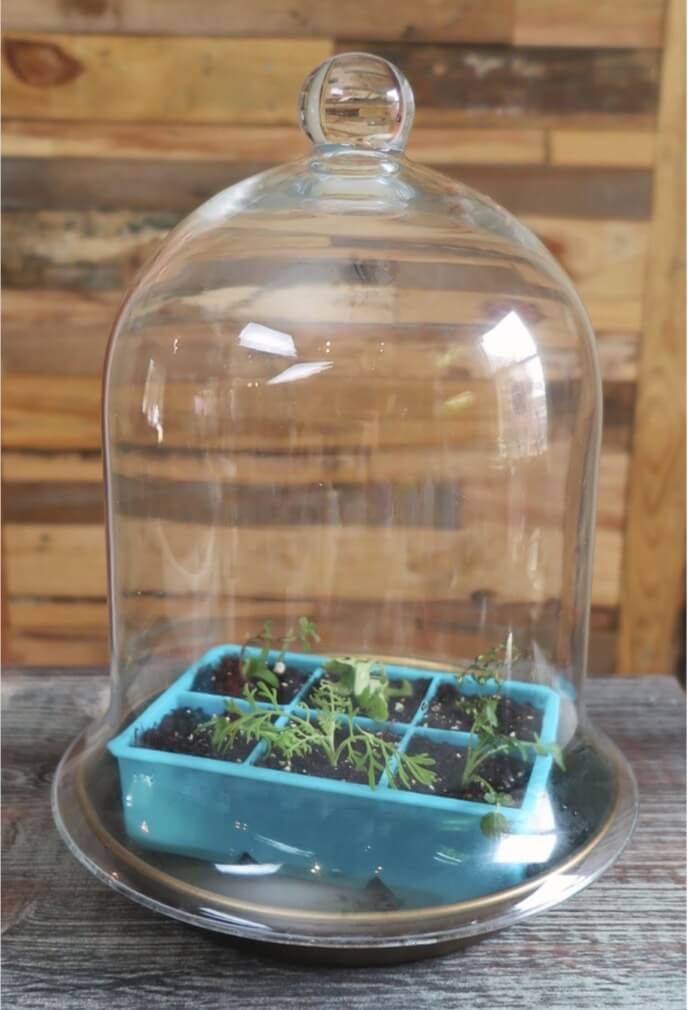
Tiếng Việt
Kiểm soát nhiệt độ và độ ẩm có thể là một nhiệm vụ khó khăn trong một ngôi nhà chạy máy điều hòa không khí và máy sưởi. Độ ẩm thấp trong nhà của chúng ta có thể nhanh chóng làm khô cây hoặc hạt non khi chúng đang cố gắng nảy mầm. Nếu bạn không có nhà kính cũng không sao, bằng cách sử dụng mái vòm độ ẩm trên các khay hạt giống, bạn có thể tái tạo điều kiện nhà kính ở quy mô nhỏ hơn. Bạn có thể mua riêng các vòm chống ẩm để lắp vào khay cắm hoặc để đậy các loại vật chứa khác. Ngoài ra còn có rất nhiều bộ dụng cụ nhà kính mini có sẵn để mua đi kèm với mọi thứ bạn cần để kiểm soát độ ẩm cho cây con và cành giâm rễ của bạn.
Nhiều mái vòm ẩm có lỗ thông hơi trên cùng hoặc bên cạnh. Sau khi hạt nảy mầm và bắt đầu phát triển hoặc cành giâm bắt đầu ra rễ, bạn có thể mở lỗ thông hơi để giảm độ ẩm từ từ. Nếu có quá nhiều nước ngưng tụ bên trong vòm hoặc bạn giữ vòm ẩm quá lâu, nấm bệnh hoặc thối rữa có thể xuất hiện. Mặc dù cây con và cành giâm cần giữ ẩm, nhưng độ ẩm quá cao xung quanh cây con có thể thúc đẩy bệnh, làm cây con hoặc cành giâm bị thối và đổ. Độ ẩm quá cao cũng khuyến khích bệnh phấn trắng trên cây con, cành giâm và cây cấy. Bạn có thể dỡ bỏ mái che độ ẩm hoặc tấm che khác sau khi tất cả cây con đã nảy mầm hoặc cành giâm đã bén rễ và bắt đầu phát triển xanh mới.
Bạn cũng có thể sử dụng nhiều loại dụng cụ làm bằng nhựa có nắp trong khác. Bạn biết những chiếchộp đựng mang đi có nắp nhựa trong hoặc hộp đựng rau nhỏ từ các nhà hàng hoặc cửa hàng tạp hóa phải không? Tôi thường xuyên sử dụng chúng làm nhà kính ươm hạt mini. Đó là một cách tuyệt vời để tái chế và tái sử dụng loại nhựa này.
Nếu không có vòm giữ ẩm hoặc các loại thùng nhựa khác, bạn có thể sử dụng túi nhựa trong để bọc bầu hoặc khay nhỏ giâm cành để tăng độ ẩm. Chọn một túi nhựa trong, không xốp, đủ lớn để chứa khay đựng sao cho cành giâm không bị nén. Đặt một chậu riêng lẻ, một vài chậu hoặc khay hạt giống nhỏ bên trong túi. Thổi một ít không khí vào túi để làm phồng túi, sau đó dùng dây buộc xoắn để đóng đầu túi lại. Phương pháp này phù hợp khi bạn tạo rễ cho từng nhóm nhỏ hoặc từng nhóm hom sinh dưỡng. Bạn cũng có thể sử dụng bình chuông và nắp đậy bằng đất nung để tăng độ ẩm xung quanh cành giâm và cây con sinh dưỡng.






![[Ebook Việt Hoá] Plant parenting – LESLIE F. HALLECK (Nhân giống cây) – HUMIDITY DOMES (Hộp giữ ẩm) [Ebook Việt Hoá] Plant parenting – LESLIE F. HALLECK (Nhân giống cây) – HUMIDITY DOMES (Hộp giữ ẩm)](https://vn1.vdrive.vn/codai.net/2021/02/ebook-huong-dan-nhan-giong-cay-canh-rau-va-hoa-03.jpg)


